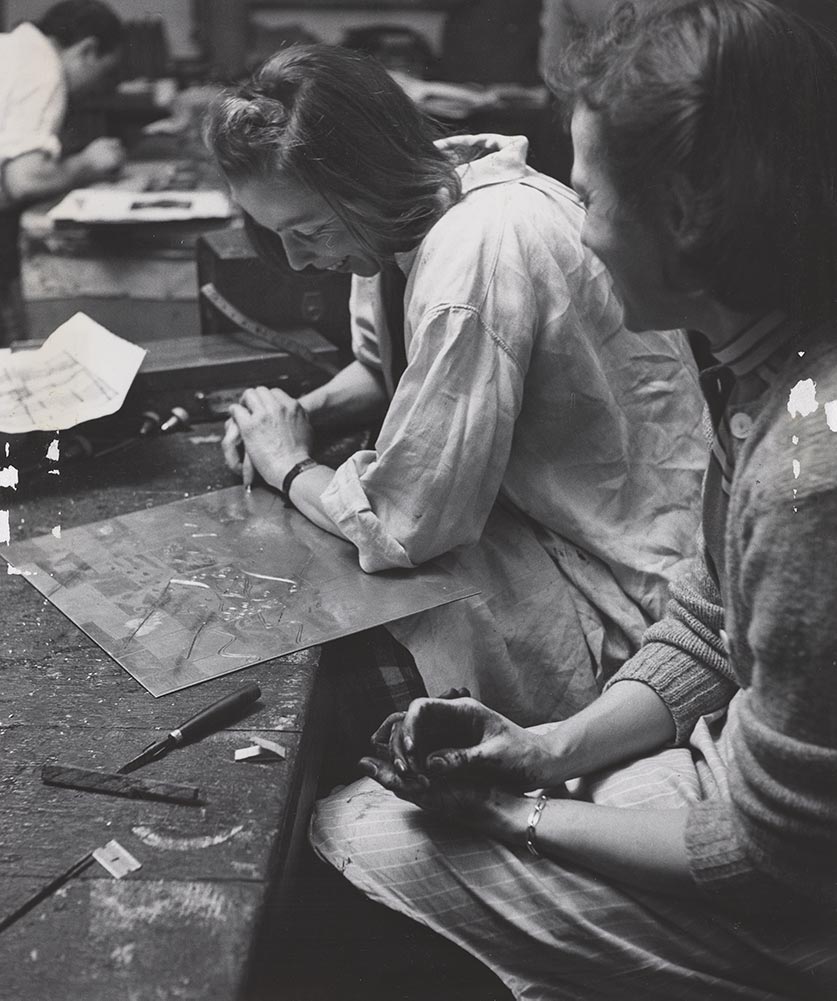43. Fannie Hillsmith
| Life Dates | 1911-2007 |
| Place of Birth | Boston, MA, USA |
| Place of Death | Jaffrey, NH, USA |
| Birth Name | Fannie Hillsmith |
Fannie Hillsmith was born in Boston, Massachusetts, and attended four years at the Boston Museum School, following in the footsteps of her grandfather Frank Hillsmith, a respected artist in the area.1 Seeking greater exposure to modernism, she earned a coveted out-of-town scholarship to the Art Students League and studied with Alexander Brook, William Zorach, Yasuo Kuniyoshi, and John Sloan during the 1934–35 academic year. Hillsmith’s career accelerated in the early 1940s as she exhibited her cubist-inspired canvases and earned positive reviews from critics such as Clement Greenberg. Norlyst Gallery hosted her first solo exhibition in 1943, which propelled her inclusion in important group exhibitions, such as the Spring Salon for Young Artists (1943–44) and The Women (1945), both at Peggy Guggenheim’s Art of This Century Gallery, and Sidney Janis’s Abstract and Surrealist Art in America (1944). Through her affiliation with Charles Egan Gallery, Hillsmith received an invitation from Josef Albers, a fellow Egan artist, to teach at Black Mountain College in the summer of 1945.2 Soon after her return to New York, she became a member of Atelier 17, working there from approximately 1946 until 1950. In addition to forming close friendships with Harriet Berger Nurkse and Alicia Legg, she valued the opportunity to work side-by-side with established European artists at the workshop’s communal tables. Prints such as The Table–Study No. 5 (1947) offer some of the best examples of her mature style, which interpreted personally significant Victorian-era domestic settings through the language of cubist structure. She showed with Atelier 17 on numerous occasions and exhibited her prints independently at venues such as the Brooklyn Museum and Philadelphia Print Club. Hillsmith continued to paint and exhibit throughout her lifetime, and her work is represented in many major public collections.
Selected Bibliography
Birmingham, Doris A. “The Art of Fannie Hillsmith.” In Fannie Hillsmith, edited by Robert Doty. Manchester, NH: The Currier Gallery of Art, 1987.
Fannie Hillsmith. New York: Susan Teller Gallery, 2007.
Hillsmith, Fannie. The Ups and Downs of Needlepoint. South Brunswick and New York: A.S. Barnes and Company, 1976.
———. “Women Speak Out.” In Art of This Century: The Women, edited by Siobhán M Conaty. New York: The Stony Brook Foundation: The Solomon R. Guggenheim Foundation, 1997.
J. K. R. “Sabbatical Showing.” Art Digest 23 (April 15, 1949): 28.
L. C. “Fannie Hillsmith.” Art News 53 (March 1954): 43.
Thompson, James. Black Mountain College Dossiers: Fannie Hillsmith. Asheville, NC: Black Mountain College Museum and Arts Center, 1996.
Notes
- Additional biographical details in Doris A. Birmingham, “The Art of Fannie Hillsmith,” in Fannie Hillsmith, ed. Robert Doty (Manchester, N.H.: Currier Gallery of Art, 1987. ↩
- Hillsmith noted that many of her students at Black Mountain were teachers looking for summer refresher courses. Margaret Balzer, then a teacher at Berea College, overlapped with Hillsmith (Hillsmith’s dates were July 2–August 4 and Balzer’s were July 9–August 19). Balzer did not take classes with Hillsmith, but they likely socialized together, and interestingly both started at Atelier 17 not long after leaving Black Mountain. Black Mountain College Papers, Western Regional Archives State Archives of North Carolina Department of Natural and Cultural Resources, Asheville; James Thompson, Black Mountain College Dossiers: Fannie Hillsmith (Asheville: Black Mountain College Museum and Arts Center, 1996), 16–17. ↩


